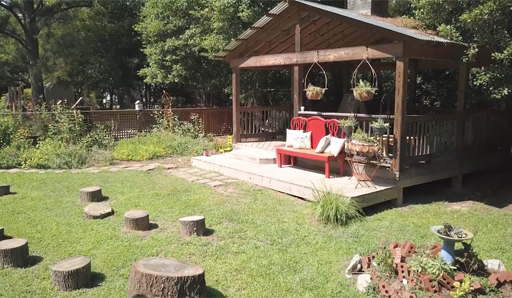3.3 A best practice toolkit
The Natural Learning Initiative has developed a Preschool Outdoor Play and Learning Environments Best Practice Toolkit Activity that you can download from their website. There is a whole section on balancing risks with benefits and this is a key challenge in practice. They have identified 13 best practice indicators although it is important to recognise that a) they have been developed for pre-schoolers rather than under twos and b) there is an explicit emphasis on physical activity as the project has a public health aim of reducing obesity.
- There are 10 or more play and learning areas.
- There is a looping, curvy, primary pathway for circulation and wheeled-toy use.
- There is a grassy lawn for games, activities, and events for many children.
- There are sufficient shady settings in addition to trees.
- There is a variety of loose materials, accessible for children to play with.
- There is sufficient portable play equipment, including different types of wheeled toys, accessible for children to play with.
- There are sufficient gross motor activities supported by the outdoor play and learning environment.
- There are sufficient trees.
- There is a proportion of trees that are edible fruiting species.
- There are sufficient shrubs and vines (including fruiting species), ornamental grasses, and perennial flowering plants.
- There is a designated vegetable garden with sufficient produce for snacking and/or meals.
- There is a covered outdoor classroom/gathering place large enough for all children in a class to use together.
- There is sufficient storage for wheeled toys, portable play equipment, loose parts, and other play and learning materials.
Activity 4 A best practice toolkit
Watch this video and then answer the questions which follow.

Transcript
SPEAKER: High quality outdoor learning environments do not happen overnight. But usually over several years as resources become available, as volunteers get interested, as funders are convinced, and as teachers become trained and excited. Implementation is guided by a master plan, but more importantly, it is a learning process for all involved. We call this incremental development.
- Which of the 13 best practice indicators do you think are most appropriate in developing an outdoor environment for babies and toddlers?
- Do you agree that creating a high-quality outdoor environment involves ‘incremental development’? Why?
Comment
Providing shady/sheltered areas is likely to be particularly important for very young children, particularly those who are not yet walking (4 and 8). Similarly, the emphasis on edible plants means that concerns about the children putting things in their mouths is minimised (9 and 10) and a vegetable garden (11) provides a clear link between growing and eating. Indicator 10 emphasises sensory diversity of plants in terms of function, height, texture and visual appeal. While it is possible to transform an outdoor space in a short period, it takes time to understand what plants will thrive and how children will interact with and use the space. An incremental approach is potentially more collaborative and can involve members of the wider community.
